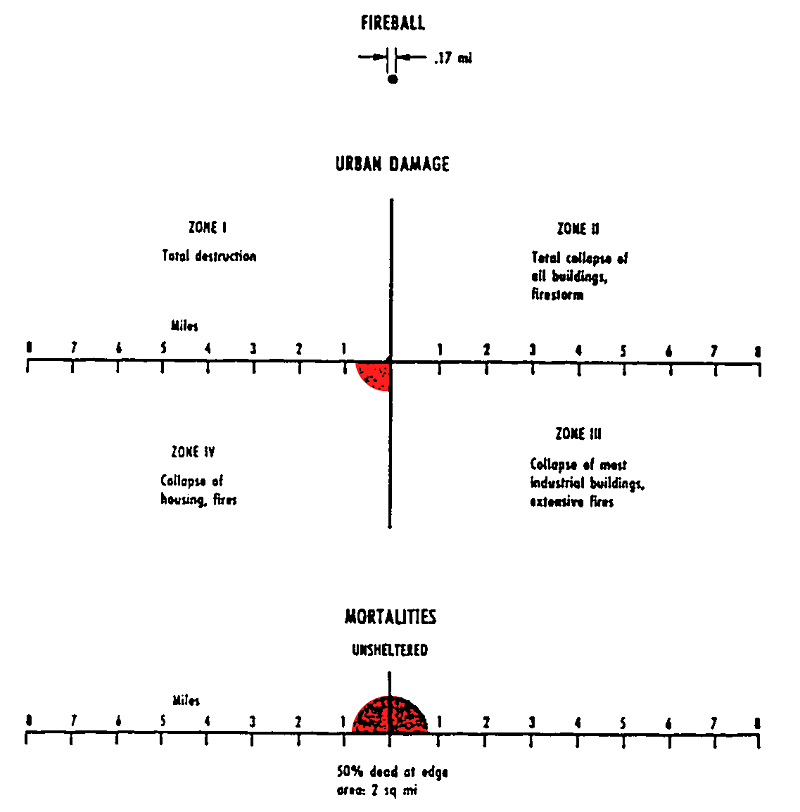
Fig. 1—Effects of a 20-KT A-bomb
- - - - - - - - - - - - - - - - - - - - - - - - - - - - - - - - - - - - - -
Late in 1951, RAND obtained information from Los Alamos indicating that nuclear weapons of substantially greater yield may be available within a few years. These weapons are expected to have a yield, measured in TNT equivalents, ranging from 1 million to 25 million tons.
A small team at RAND was given the task of appraising the implications of the new weapons. In March of this year the results of this appraisal were reported to the Air Staff, to the Office of the Secretary of Defense, to the Strategic Air Command, and subsequently to the cognizant agencies responsible for atomic research and development and to the National Security and Resources Board.
This summary report and several technical memoranda record the work accomplished to date on this study. Further research is now in progress at RAND.
- - - - - - - - - - - - - - - - - - - - - - - - - - - - - - - - - - - - - -
Thermonuclear weapons of very large yield may be developed and added to the weapon stockpile in the near future. These weapons will be available and deliverable in quantity at a later date. Because of the power of such weapons, area rather than point targets will be destroyed, and cities and their populations will be devastated.
The physical effects of very-large-yield nuclear weapons have been calculated. The effectiveness of such weapons, used in a strategic offense against the enemy (or ourselves), has been estimated. Implications for national defense are drawn. Finally, some of the political consequences of such an addition to the arsenal of war have been suggested.
- - - - - - - - - - - - - - - - - - - - - - - - - - - - - - - - - - - - - -
Preface
Summary
Introduction
Soviet Capabilities
Weapons
Effects
Strategic Offense
Defense
Ground Warfare
Political Implications
- - - - - - - - - - - - - - - - - - - - - - - - - - - - - - - - - - - - - -
KILOTON FISSION WEAPONS
The atomic bomb dropped at Nagasaki had a yield of 20 kilotons (KT). That is, it released about the same amount of explosive energy as 20,000 tons of TNT. Since Nagasaki, Los Alamos has done an outstanding job of developing smaller and larger fission weapon [ DELETED DELETED DELETED DELETED DELETED DELETED ] We could have A-bombs with yields equivalent to 500 KT, and, in the future, we could probably make a 1000-KT bomb by relatively straightforward methods. A 1000-KT bomb—yielding the equivalent of 1 million tons of TNT—is a megaton bomb.
MEGATON FUSION WEAPONS
Late in 1951, Los Alamos gave RAND some data on potential weapons based on some brilliant new scientific work. The estimates are still somewhat speculative, but a test shot of a new weapon will soon be made. There is now a high probability that in the not too distant future we can have many thermonuclear, or fusion, bombs with megaton yields. They need not be extremely expensive or excessively large. As a result, this country may soon face a radically different situation in the weapons field.
The Los Alamos estimates of the size of the new weapons range from 12,000 to 80,000 lb with diameters from 5 to 10 ft. The principal stockpile A-bomb is 5 ft in diameter and weighs 8500 lb. The thermonuclear bombs will "cost" about twice as much as the standard stockpile A-bomb, in terms of scarce materials.
- - - - - - - - - - - - - - - - - - - - - - - - - - - - - - - - - - - - - -
We have nonspeculative, concrete evidence that the USSR is technically mature in the atomic-weapons-design field. Information on the Soviet A-bomb shots in September and October, 1951, is quite specific. They are producing high-efficiency weapons, and excellent scientists are working on their atomic-energy program. It is clear that Soviet capabilities in the atomic field are high in research, development, and probably in production.
There is some evidence that the Soviets were actively experimenting in the thermonuclear field after 1946. There is also some intelligence information which is difficult to explain in any terms other than as development by them of thermonuclear weapons. Our country did little thinking in the thermonuclear field between 1946 and 1949; the Russians may well have continued to think and work during that 3-year period.
While there is little sign of Soviet industrial effort associated with such a program, the evidence we have is not negative. The industrial effort need not be extremely large in comparison with a standard atomic effort.
[ DELETED DELETED DELETED DELETED DELETED DELETED DELETED DELETED DELETED DELETED DELETED DELETED DELETED DELETED DELETED DELETED DELETED DELETED DELETED DELETED DELETED DELETED DELETED ]
We must assume that the USSR can have fusion bombs of one form or another sometime in the near or distant future. They may have done better: they may be abreast of us or even ahead of us.
In any case, the time will come when the Russians can have many megaton H-bombs if they want them.
Finally, while the Soviets would have a difficult delivery problem, they have the technical ability to develop the means of aerial delivery if and when the bombs are available.
- - - - - - - - - - - - - - - - - - - - - - - - - - - - - - - - - - - - - -
There are still substantial uncertainties regarding the expected effects of very-large-yield thermonuclear weapons. For this reason, conservative estimates have been used in this study. Nevertheless, thermonuclear bombs will be killers and fantastically destructive.
[The Effects of Large-Yield Atomic Bombs, The RAND Corporation, Research Memorandum RM-866. July 8, 1952 (Secret—Restricted Data).]
Nuclear weapons destroy in three ways:
1. Blast—terrific pressures, with winds, both along the ground and in updrafts.
2. Thermal (or heat) radiation.
3. Gamma radiation—gamma rays are like X-rays in biological effect, but are more energetic and penetrate greater thicknesses of air and other materials.
The primary effect of blast is to crush and blow down buildings. When the blast overpressure is sustained for seconds (as it is with A-bombs) or for even longer periods (as with H-bombs), it also kills people directly.
The thermal radiation comes from the fireball, which has a surface temperature about equal to that of the sun. Anything it touches, or is close to, will be fused or melted. The amount and duration of this radiation is rather uncertain; its effects are even less certain, because they depend on the type of material or object exposed and also on the amount of moisture and haze in the atmosphere. But, generally, in the case of megaton bombs, the heat will be sufficient to kill people and start fires miles from the point of burst.
An earlier estimate by RAND seriously overstated the expected gamma radiation from H-bombs. While significant, the effects appear now to be dominated by thermal radiation and blast.
Various nuclear weapons may be compared in terms of their effects on a city target.
As a point of reference, Fig. 1 presents the effects of a 20-KT Nagasaki-type A-bomb detonated near the ground. Four zones of damage are shown.
In Zone I, corresponding more or less to the area under the fireball, all buildings are pulverized, and all life, in or out of shelters, is destroyed by blast, heat, and gamma radiation.
In Zone II, all buildings are either completely leveled or so severely damaged as to be totally useless. Their contents are destroyed and most of the inhabitants are killed.
In Zone III, all but the heaviest and strongest structures are demolished.
In Zone IV, one- to four-story dwellings are destroyed. In this zone, concrete buildings and underground shelters may offer considerable protection.
Mortality rates among an unsheltered city population are also shown in the -figure. These rates, based on Hiroshima-Nagasaki data, are for an unwarned population and have been adjusted for Western building standards. At the edge of the area indicated, about one-half of the people are killed; the rest are injured sufficiently to require immobilization and continued care. Nearer ground zero, a larger proportion are killed. Farther away, fewer are killed. For example, if the colored area was uniformly populated, about three-fourths of the inhabitants would have been killed.

Fig.
1—Effects of a 20-KT A-bomb
Figure 2, drawn to the same scale, shows the expected effects of a 5-MT bomb. The diameter of the fireball is striking—and its effects are terrifying.

Fig.
2- Effects of a 5-MT H-bomb
Over and above the greater areas of destruction from blast resulting from this bomb, there is another factor to be considered: the increased probability of fire. The heat radiation from a fusion bomb is relatively greater in each of the zones of destruction than it is for a low-yield atomic bomb; in addition, the distances are so large that there is a greater chance of radiation's kindling fires before the blast wave arrives. After the quenching wind from the blast passes, the fire may be rekindled and fanned by the gentler reverse wind. An extensive firestorm must therefore be expected as far out as Zone IV— provided this zone includes densely built-up areas.
The figure shows mortality rates for two cases: a sheltered and an unsheltered population. The shelters assumed are those currently considered adequate for protection against blast, both in this country and elsewhere. There is serious doubt as to whether the conventional shelter would be adequate under the conditions created by such a large-yield bomb. People in such shelters may be asphyxiated or roasted. Those who try to leave the shelters will be killed in the firestorm. Those who remain may be trapped and asphyxiated. Only if the shelter is close to the periphery of Zone IV would escape seem possible. A redefinition of "adequate" shelters may be in order.
Figure 3, also drawn to the same scale, shows the effects of a 25-MT bomb.
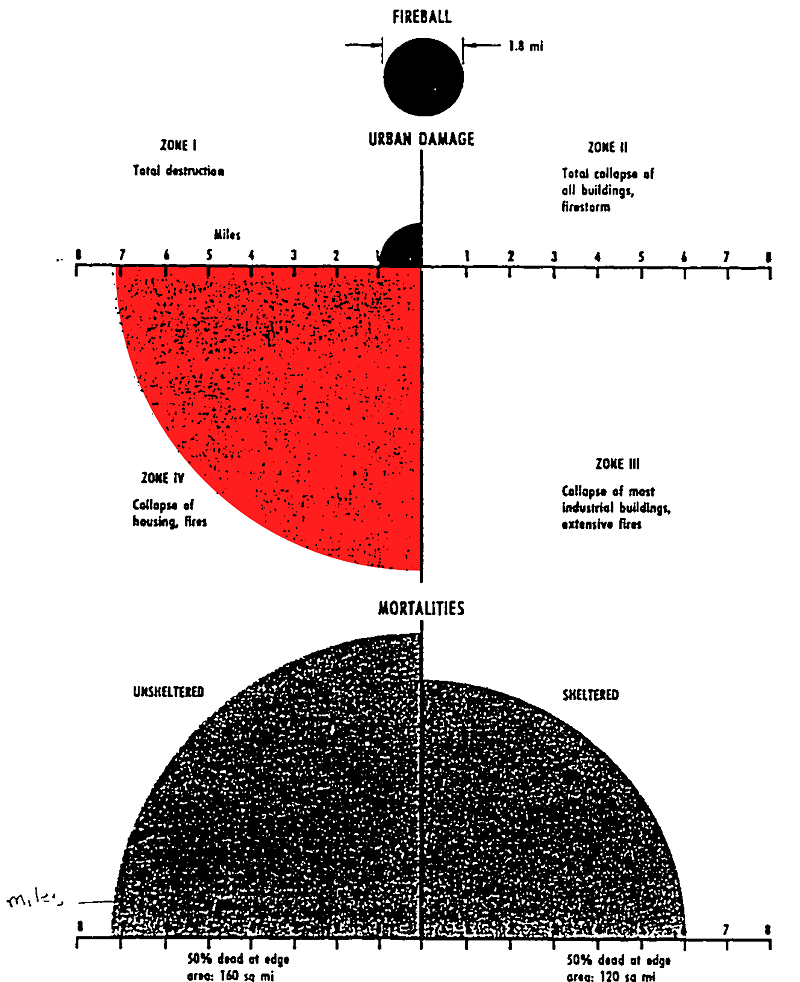
Fig.
3—Effects of a 25-MT H-bomb
Although the weapon poses difficult delivery problems (*), even one of the largest bombs predicted by Los Alamos can be carried by existing or expected aircraft—however, some tinsmithing and modification will probably be necessary.
[* - Thermal Radiation and Aircraft Escape Problem for Large-yield Bombs, The RAND Corporation. Research Memorandum RM-867. July 10. 1952 (Secret—Restricted Data).]
Present estimates of weapon effects indicate that the B-47 and XB-52 may be able to deliver a 10-MT weapon in a conventional manner and escape; the B-36 will have only a marginal chance of escape. The B-47 and XB-52 may have only a marginal chance of escape after delivery of a 25-MT bomb. The risk is from thermal radiation; in general, there is no danger from blast or gamma radiation.
Figure 4 illustrates the problem.

Fig.
4—Schematic of H-bomb delivery problem
The bomber releases the bomb at the point "X" and makes a sharp turn, not quite 180°. The bomber is at an altitude of about 43,000 ft. The bomb is detonated at 5000 to 8000 ft. By the time the bomb goes off, the carrier is 50,000 ft away from the point of burst. By the time the blast catches up with the bomber, it has traveled another 40,000 ft. The skin of the bomber will be very hot—and windows will have to be shielded. However, if the drop-time of the bomb could be lengthened by 50 or 60 seconds, or if the structure of the airplane were modified, any of the three airplanes could almost certainly escape from any bomb mentioned here.
There are, of course, other delivery techniques. A small bomb (of nearly A-bomb size) would make an air-to-surface missile like the Rascal carried by the B-36 look interesting. The Wright Air Development Center is already well along on a pilotless, or drone, B-47 to carry a 50,000-lb, 6-ft-diameter bomb. A little ingenuity will certainly produce other alternatives.
- - - - - - - - - - - - - - - - - - - - - - - - - - - - - - - - - - - - - -
Conventional air delivery of thermonuclear bombs will be more difficult than that for A-bombs. But these bombs can accomplish destruction on a scale which is quite different from anything that can be achieved with present-day A-bombs.
[ Implications of Potential Weapon Developments for Strategic Bombing and Air Defense, The RAND Corporation, Research Memorandum RM-868. July 10. 1952 (Top Secret—Restricted Data).]
Most of our recent war plans have envisaged a retaliatory air offensive with A-bombs against industrial targets—aircraft factories and oil and munition production plants—and against certain military installations. One very elementary consideration, which enters into the probable success of such an operation, is "bomb coverage"—i.e., likelihood of destroying a given target.
Table 1 Compares the probability of killing such targets with 150-KT, 5-MT, and 25-MT bombs. [DELETED DELETED DELETED DELETED DELETED DELETED DELETED DELETED DELETED DELETED DELETED DELETED DELETED DELETED DELETED DELETED DELETED DELETED DELETED DELETED DELETED ] Good bombing accuracy is generally conceded to result in a circular probable error (CEP) of 3000 ft; i.e., half the bombs fall within 3000 ft of the target, and half fall farther away. Poor accuracy might result in an 8000-ft CEP.
Table 1
|
|||
|
Zone |
Bomb Yield |
CEP = 3000 ft |
CEP = 8000 ft |
|
III |
25 MT |
1.0 |
1.0 |
|
3MT |
1.0 |
0.8 |
|
|
150 KT |
0.6 |
0.13 |
|
|
II |
25 MT |
1.0 |
0.8 |
|
5 MT |
1.0 |
0.5 |
|
|
150 KT |
0.3 |
0.05 |
|
Some of the industrial targets considered are "hard," i.e., physically resistant. They will be destroyed only if they, lie within Zone II, as defined above. Certain steel and electric power plants are in this category. "Soft" targets will be destroyed even in Zone III. Refineries and aircraft production plants are in this category. If the target is soft and if the bombing accuracy is good, not very much is gained by using an H-bomb. If the bombing accuracy is poor or if the target is hard, then a great deal is gained in destruction through the use of very-large-yield weapons.
The new weapon will inevitably be an area weapon: housing will be demolished at a distance of more than seven miles from ground zero with a 25-MT bomb. Although some industrial installations in a city attacked with an H-bomb may survive complete destruction, the city itself will be demolished. In addition to the wholesale physical destruction which will result from the use of this weapon, there will be a vast increase in the number of people killed.
Suppose a thermonuclear weapon were to be aimed not at industrial plants and military installations, but at the centers of cities. In most cases, industrial targets would be destroyed anyway. Figure 5 estimates the number of people killed by dropping H-bombs on the fifty largest cities in the United States and the USSR. In this example no bombing error is assumed. The population is assumed to be unwarned and unsheltered. These estimates therefore represent an upper bound on expected mortalities. In passing, it may be noted that the 5-MT bomb would be comparatively less effective against United States targets, as a consequence of United States suburban development.
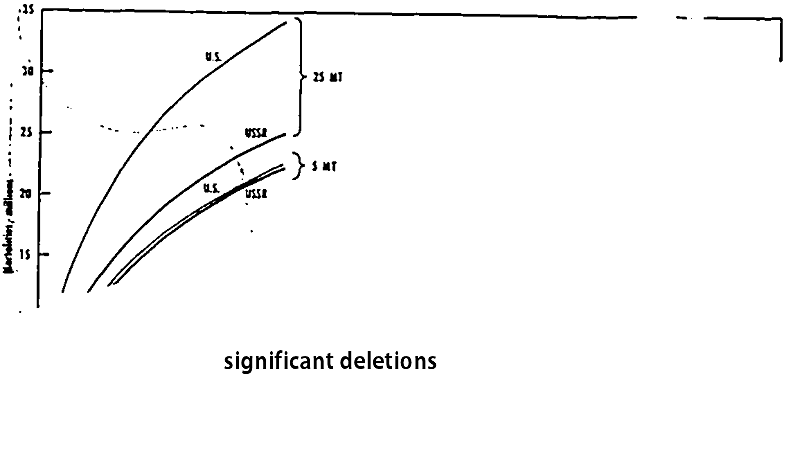
Fig.
5—Mortalities in the United States and USSR from A- and H-bombs
For comparison, the figure shows the number of deaths to be expected from a campaign using A-Bombs [ DELETED DELETED DELETED DELETED DELETED DELETED DELETED ]
Thermonuclear weapons will be killers. However, an attempt might be made to minimize enemy casualties. First, a campaign might be launched against a non-urban industrial and military target system. Because of the limited number of such targets distinct from Russian urban areas, it is unlikely that we could attain our military objective with such a campaign.
Second, we might warn the target population in time to permit evacuation. This tactic perhaps deserves serious consideration, taking into account the full risk and possible cost to us as well as the advantages to be gained.
[Warning of Target Populations in Air War: A Progress Report, The RAND Corporation. Report R-167. November. 1949 (Secret).]
There is no doubt that possession of these bombs by both the United States and the Russians would seriously worsen our relative position in strategic bombing. At present we can accomplish sufficient destruction with stockpile A-bombs to achieve our mission of preventing Soviet industrial mobilization after war begins. For us, the H-bomb is primarily insurance: it increases the certainty of the success of, and probably decreases the cost of, a retaliatory campaign.
For the Soviet Union, possession of the H-bomb would be of much greater significance. The damage they can do with A-bombs, while extremely serious, is probably not comparable with what we can do to them. They have a smaller stockpile, a lower delivery capability, no advance bases, and no experience in long-range strategic bombing. They must attack a larger and more resilient economy. Even a moderate Soviet stockpile of megaton bombs would go far to redress this imbalance. By dropping only 50 bombs, with little skill in selecting targets or in hitting them, the Russians could cause destruction and death on a scale which would, at a minimum, interdict our industrial mobilization for years and would, at a maximum, prevent us from carrying on a war at all. The United States could scarcely accomplish more with a numerical superiority in bombs and greater skill in delivery.
- - - - - - - - - - - - - - - - - - - - - - - - - - - - - - - - - - - - - -
What possible defense measures might we take to cope with this threat? By far the most important is to do all in our power to deter the attack. The most effective way to do this is to maintain a strong and relatively invulnerable Strategic Air Force armed with thermonuclear weapons. The defense of SAC should have highest priority for the defense of the United States.
An effective active air defense would be worth almost any price. In fact, a defense system with a very high "kill potential" against enemy bombers appears to be not too expensive and certainly well within our means. Moreover, it would have special value as a deterrent. If the Russian attack should fail because of active defenses, they would lose hot only the bombs, but also their elite crews and very valuable bombers. However, because we can never be sure that we shall not be taken by surprise, that an enemy will not use a tactic that we have not foreseen, and that our defense system will not be highly degraded in the early stages, we must not place full reliance on active air defense.
General dispersal of our industry and population, on a scale to provide real protection, appears so expensive in its direct cost and in its reduction of economic efficiency as to be an impractical measure. It would involve rebuilding most of our cities and industries in a different place, and if we undertook this we should have no resources left to attempt anything else.
In addition, general dispersal may buy very little protection. If dispersal should assume any particular form, the attacker could, within limits, simply change his aiming points and attack a different target system. There are alternative ways in which he could knock out our industrial mobilization potential. If we decided that the greatest threat was to our major cities, we could spend the next 10 years dispersing them. He might then launch a completely successful "vertical" attack against basic industries essential to war production, the location of which was unaffected by city dispersal. Conversely, if we put a tremendous effort into dispersing and reducing the size of plants in our basic industries, our cities and their populations would remain almost as vulnerable as they are now. Moreover, unless dispersal is combined with a very active air defense, it merely increases the number of bombs required on target: these bombs are not very expensive and will in time be plentiful. If the attrition we can inflict is low, delivery will also be cheap. The Soviets could easily maintain an advantage by making more H-bombs and more airplanes if we did nothing but disperse.
Some limited and selective, as opposed to general, dispersal is certainly both feasible and desirable. We should encourage the "spreading out" of cities. The current National Security Resources Board dispersal policy amounts to this: trying to get new industrial facilities, which are going to be built anyway, located well away from present heavy concentrations. In a period of 10 years or even longer, not much protection would result, but the cost would be small and some protection would be better than none.
Selective dispersal of our most critical military installations is clearly indicated. Attention must also be given to the dangers inherent in the high degree of concentration of our military and civilian authorities in Washington.
One defense measure, which deserves serious consideration, is the building up and maintaining of a war reserve of military equipment which might enable each of our major commands to fight on an austerity basis for an extended period without fresh supplies from the economy. Such a program appears economically feasible and would provide some deterrence and protection. Our chief worry concerning the success of our own SAC offensive is that Russian forces in being and war reserves are large enough to enable them to achieve their military objectives, however effective our bombing of Russian industry might be.
Several other measures of passive defense still make sense when the H-bomb is the threat. One is the construction of shelters. Conventional blast shelters are cheap but may not provide adequate protection against the H-bomb (see Figs. 2 and 3). We believe that adequate shelters can be designed and that some such protection may be worth the cost. The whole problem must be re-examined.
Another program which deserves reconsideration is the planning in advance for large-scale evacuation. Another, is planning for the care of survivors.
We must face and accept the fact that none of these measures, or any combination of them, can give us more than partial invulnerability in a war in which strategic bombing with H-bombs is undertaken by both sides. Our chief hope must be that a relative invulnerability may prevent such a war from occurring.
- - - - - - - - - - - - - - - - - - - - - - - - - - - - - - - - - - - - - -
Thermonuclear weapons will have profound implications for ground warfare.
Figure 6 presents estimates of the effects of a 25-MT bomb on troops and materiel in the field. The height of burst (5000 to 8000 ft for a 25-MT bomb) permits limited protection for troops in ordinary foxholes. The lethal radius is smaller than in city bombing because troops will not be killed or injured by collapsing buildings or by fires.
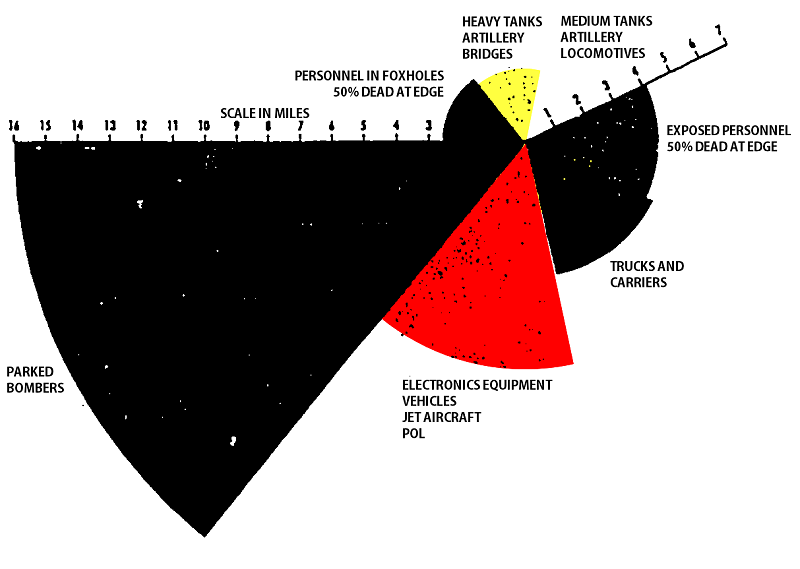
Fig.6—Effects
of a 25-MT H-bomb on military personnel and materiel
The utility of very-large-yield weapons for tactical warfare has been studied for a hypothetical ground-warfare situation.
[Thermonuclear Attack on an Army Group, The RAND Corporation, Research Memorandum RM-869. June 16, 1952 (Top Secret—Restricted Data).]
Figure 7 represents the deployment of a Russian army group in Western Europe. The force is deployed on a 78-mi front along the Rhine to a depth of 140 -mi. The group consists of three armies comprising 27 infantry, 12 mechanized, and other divisions and totaling 830,000 men. The deployment is as for an attack within a week. Personnel density is shown topographically in Fig. 7. We have assumed that a partial tactical adjustment has been made for the expected use of atomic weapons: the maximum concentration is one-third as great as for the mass offensives used by the Red Army in World War II.
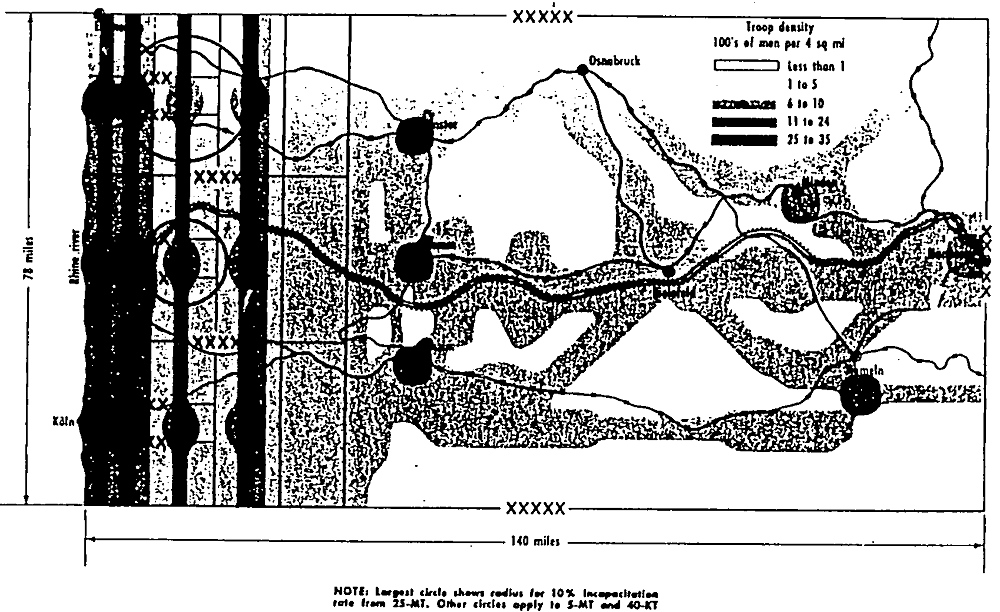
Fig.
7—Deployment of ground forces: topographic schematic of troop
density
Aerial delivery may be counted on even in the face of enemy air superiority, because we shall be able to pick the time and the place, and the penetration will be shallow. Furthermore, intelligence requirements and bombing accuracy will not be nearly so critical as for A-bombs.
Three 25-MT bombs aimed on the basis of good intelligence would kill and injure 100,000 enemy soldiers. Three such bombs delivered with less accuracy and farther from the front line would kill and injure 75,000 enemy soldiers. In each case, 5-MT bombs would be about half as effective. To achieve the same results, as many as 50 to 300 40-KT A-bombs would be required (depending on the quality of intelligence and bombing accuracy).
While there is little analysis to support the conclusion, it does appear that the offensive force is relatively more vulnerable. The defensive forces would have a comparative advantage over an enemy using similar weapons: small units well dug in and supplied by self-sufficient, mobile units should be relatively invulnerable. It would be the attacker who would have to be exposed in force.
The supply support of both sides would be highly vulnerable—particularly our own, which might be expected to require extensive European port facilities.
It may be concluded that the H-bomb is likely to be many times as effective as the A-bomb for tactical purposes.
- - - - - - - - - - - - - - - - - - - - - - - - - - - - - - - - - - - - - -
The political problems which may arise in connection with so destructive a weapon seem even more elusive and more difficult to appraise than their military and economic counterparts.
This fall we are going to test a crude thermonuclear bomb. In any event, our progress in this field is becoming more and more widely known. This, in itself, creates an important problem. At some future time the United States government will make an official announcement of this progress. What will be the most auspicious political circumstances under which such an announcement may be made? What form shall it take? What effects will this announcement have on the peoples of the world—our own, Allied, neutral, and Soviet? Which of these effects can be assessed in advance? How can the timing and the character of the announcement be manipulated to heighten whatever good effects -may be derived and to diminish the evil effects? Furthermore, we cannot dismiss the possibility of an H-bomb test, or of an announcement of such -a test, by the Russians at any moment. What should be our reaction in this event?
Perhaps we are prone to emphasize the importance of our weapon capability as a deterrent. At the same time, we cannot lose sight of the fact that our allies are very vulnerable to even the present limited stockpile of Soviet atomic weapons. Their sensitivity may assume increasing importance as the existence of ever-more-powerful weapons of mass destruction becomes known.
Different problems will be posed in the not too distant future, when either we or the Russians, or both, will have a stockpile of thermonuclear weapons. It is difficult to predict the international situation which will then exist. We can hardly guess at the temper of the American people and the disposition of our allies at that time. However, the time when we shall have to face these problems may not really be very far away, and we cannot afford to postpone consideration of them.
Despite the uncertainties, a few general aspects of the future situation may be suggested.
First, neither the United States nor the Soviet Union will have anything like the monopoly of destructive power which this nation possessed in the years 1948-1950. Whenever the H-bomb appears as a substantial stockpile item, both the United States and the Soviet Union will have a large stockpile of A-bombs. This fact must be borne in mind when one considers the three possibilities of H-bomb stockpile development: a temporary American monopoly, a temporary Soviet monopoly, and a duopoly, or possession of a stockpile by both sides.
Second, the advantage in number of atomic weapons and in efficiency of delivery techniques which we presently enjoy is likely to continue for some time—perhaps permanently—but the significance of that advantage (as far as the safety of our cities is concerned) is bound to diminish rapidly in the future. As the number of fission and thermonuclear weapons available to both sides increases, it may be numbers of exposed targets, in the event of a large-scale war, rather than numbers of weapons available which may become the determinant of losses. This prospect would seem to be unaffected by other military capabilities—air, ground, or naval—which might reinforce or partially offset the effect of the H-bomb on the total military balance of power.
Third, the political objectives of war cannot be consonant with national suicide, and large-scale reciprocal use of atomic and thermonuclear weapons against cities would not fall short of national suicide for both sides.
In such a situation, which we cannot exclude from our deliberation, there would be no large, industrially powerful nation left outside the areas of devastation to offer help to those afflicted. The question raised in the context of these dismal considerations would demand an answer if for any reason our policy of deterrence should fail. In the event of war, the chief problem might well be to find some means of controlling events after hostilities begin. The price of control, if it is possible to achieve control at all, might include not only limitations on the means of waging war, but also limitations on our war objectives. Total victory might become an obsolete concept.
Fourth, one of our national aims is defense of the free world in order to enable it to remain free. If, as we must, we assume this aim to be unaltered over the period under review, we must postulate continued efforts on our part to develop a growing strength to wage war, if need be.
There are other general conditions, bearing on the political implications of the H-bomb, which one may assume for the relatively near future. These may include, for example, the growing strength of NATO, a United States military budget not drastically below the present level, the continued disinclination on our part to embark upon preventive war, and the continued unwillingness to use an ultimatum at the risk of war to force Soviet disarmament or territorial retreats. Regardless of our convictions and preferences, however, assumptions of this kind are perhaps somewhat less certain than are the four basic factors we have mentioned. If this is true, these lesser assumptions will have to be considered in an analysis as being questions to be examined in their own right.
Whatever the answers may be to the questions we have raised and to the many other weighty problems which may be of equal or greater importance, we may lose our ability to deter the Soviet Union from aggression and indeed may lose our chance of national survival if we do not develop thermonuclear weapons at the most rapid rate possible.